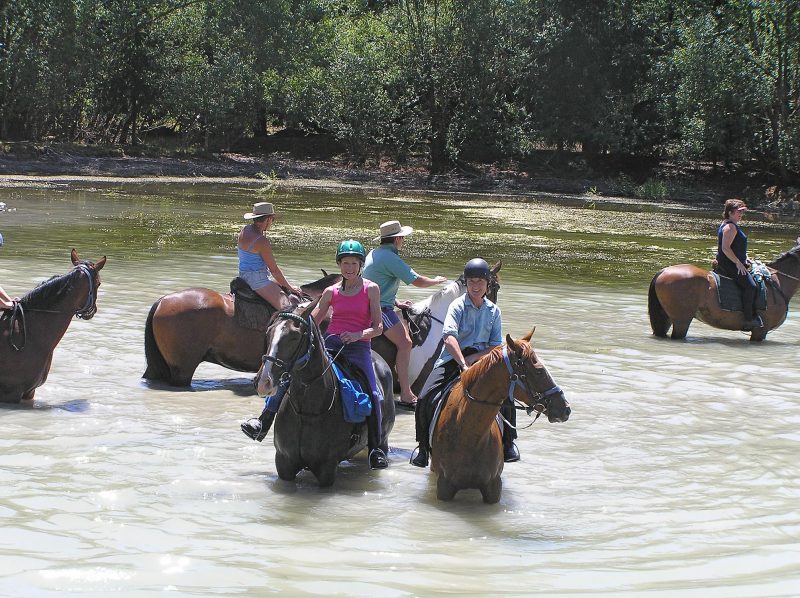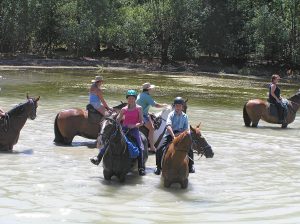by JENNY MCPHEE
Wild turkey alerts, fallen trees, bull challenges and the distinct possibility of getting lost are all encountered by riders who follow high country tracks on our Christian fundraising three-day horse trekking. We have been doing South Island high country horse treks annually for 18 years.
Riders depend on us, the leaders. We depend on God.
With sporadic cellphone coverage, we carry an EPIRB (Emergency Position Indication Radio Beacon) and have radio contact between riders and vehicles. Lack of GPS is replaced by pink clothes pegs on gateways, rocks that look like faces, possum traps in trees and, on one occasion, a white sign with an arrow showing “This Way”, put out at dawn by an amazing station manager who just knew (and he was right) we’d go the wrong way.
He had bulldozed part of the track the previous day, which helped the backup vehicles negotiate a hairpin turn, and confirmed the direction of the boundary change. We followed directions like, “after the possum traps, past the swamp, about 2km round a corner you’ll see the welcome swallows”. Yes, they were there, as were paradise ducks.
Some of our 48 riders had dressage or show ring experience. Now they are also competent back country riders, able to recognise the tall red-brown grass that warns of a swamp. Maybe helped by the bleached cattle horns protruding just above the surface, or their horse’s snort and sudden stop.
They know to make sure the rider behind them is still there, and to shout “sheep alert” as a stray bolts along the fenceline for the gate.
Some narrow tracks have drops of 60m or more. Riders skirt boulders on the track, having fallen from the slopes above — fortunately not as we passed by.
Lunch is a welcome break, delivered by our ground crew/truckies who have usually had an exciting time negotiating river boulders and banks to make the lunch spot.
The stop is carefully chosen, near willow trees for horse tie-ups, with shade and water for a drink or a swim. An hour sometimes turns into two as the morning’s ride is celebrated with dagwood sandwiches filled with ham off the bone, lettuce, cheese and tomato. Stories are told of the near misses, truckies bogged and the wind on the tops that nearly blew us off our horses.
On Mt Virginia Station we survived the wild turkeys rustling in the bushes alongside the track, and stopped for a rider with an unintended dismount when her horse leapt off all fours at a creek. A generous rider swapped her quiet horse, an act of love that is typical on our rides.
We pass patches of flowering manuka, alive with bees.
From a soft moss and fern carpet base, towering black beech trees dictate our path. We hurry past, the tree is the home of wasps known to be attracted to sweaty horses.
A clearing produces an enchanting musterers’ hut complete with a small tin bivvy full of chopped wood.
Further ahead our track is blocked by an old black tree: not chopped, not jumpable and with no way round. It had fallen since the pre-trek recce.
The chainsaw usually carried has been left behind so, with much laughing and an opportunity for the men to shine, and gain extra points for their team, the tree is lifted as in the pioneering days, off the track.
Points collected for acts of heroism on the rides, such as getting off and opening the gate, or leading a reluctant horse through a creek, are added to concert night performances, to win the cup, a part coconut on a stalk, on a stand. Station owners and families come from stately homes often surrounded by old redwoods, English oaks and beautiful rhododendrons. They celebrate Christmas at their favourite place on the station — their musterers’ huts.
For us it is three days of fun among the rocks, creeks and wildlife.
We are aware the beauty comes with a cost. Bank managers to see, low wool prices, snow raking (pulling sheep out of the snow one by one), rabbit plagues, and the foot problems that come with that extra bit of rain that makes the native grasses ripple so beautifully. We are grateful for the generous sharing of their homes.
The My Wilderness Trust has the aim of providing funding to promote an awareness of God through the media. Donations have been given to Shine TV towards the new transmitter/aerial on the hill in Christchurch, and to the “Come to the River” group, to help produce Christian DVDs for use in prayer groups and Life in the Spirit Seminars.


Reader Interactions